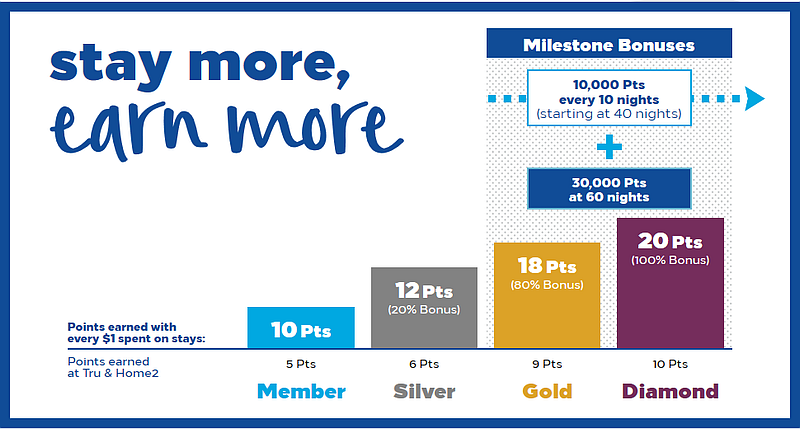Starting Monday, Hilton unveils changes to the Hilton Honors loyalty program. Most of the changes rank as evolutionary, rather than revolutionary. However, there are some clear winners and losers that you should consider going forward.
The Existing Honors Award Structure
Currently, Honors awards 10 “base points” per dollar spent at most brands (5 at Tru and Home2Suites properties). Elite members also earn status bonuses depending on level. Assuming you choose the extra 5 points as your “double dip” bonus, the following chart shows how many points you currently earn in the program at most hotels.
| Status Level | Member | Silver | Gold | Diamond |
| Status Bonus | 15% | 25% | 50% | |
| Effective points per dollar | 15 | 16.5 | 17.5 | 20 |
The new program, meanwhile, eliminates the double dip, but increases status bonuses at all levels.
In short, Gold and Diamond members earnings remain basically the same. Silver and non-elite members, though, see a fairly significant reduction. And of course, if you selected airline miles in lieu of the Honors points, you lose that option entirely. Hilton claims a very small fraction (they say only about 1%) of members used this option.
A Real World Example
I recently completed a four-night stay at The Roosevelt, a Waldorf Astoria property in New Orleans. (In case you’re wondering, that’s the birthday surprise for my wife mentioned in my year-in-review post.) That stay racked up $1,493.60 in room and tax charges, for 14,936 base points. This chart shows Honors points earned under both the current and new systems with bonuses. This assumes you choose extra points as your double dip option.
| Status Level | Member | Silver | Gold | Diamond |
| Current points + bonus | 22,404 | 24,644 | 26,138 | 29,872 |
| New points + bonus | 14,936 | 17,923 | 26,885 | 29,872 |
| Difference | (7,468) | (6,721) | 747 | 0 |
At a value of 0.4 cents/point, a non-elite member loses $29.87 of point value in the new system. Silvers, meanwhile, lose $26.88. Not the end of the world, but still a meaningful reduction.
Let’s look again at what happens if you choose miles as your double dip, though. Count me among the alleged “1%” that actually takes miles instead of points. Why? Hilton previously allowed double dipping in Virgin America’s Elevate program. After the Alaska merger, though, you could choose Mileage Plan as your double dip partner. Alaska provides decent value compared to other frequent flyer programs. I’d say 5 Honors points roughly equals the value of one Mileage Plan point. And I’d rather have the airline miles, all things equal.
In my case, as a Gold member, I earned 18,670 Honors points (14,936 base points plus 25% bonus). In addition, I picked up 1,436 Mileage Plan miles. Using a value of 0.4 cents/point and 2 cents/mile, that’s $104.54 of points and miles. Under the new system, 26,885 Honors points alone equals $107.54 of value. So looking at it that way, it’s basically a wash. Of course, if you travel frequently and spend 60 nights a year in hotels, that could have added up to 21,540 Alaska miles in the above example. That gets you a meaningful stash towards a redemption to Europe or Asia. On an intangible basis, losing that option does potentially hurt.
Other Changes
Of course, the points earning changes garner most of the attention, but there are other changes worth thinking about.
- Milestone Bonuses. Hilton introduces extra bonus points for highly frequent travelers, with a bonus of 10,000 points every 10 nights beginning at 40 nights, and an extra 30,000 at 60 nights.
- Elite Rollover Nights. Taking a page from Delta’s playbook, elite members can now “roll over” nights towards next year’s elite status. For example, if a Silver member stays 13 nights, 3 roll over to next year’s status.
- Gifting Elite Status. Diamond members can gift Gold status. Reach 100 nights, and you can gift Diamond status.
- Breakfast at Waldorf Astoria properties. This actually began earlier this year. Gold and Diamond members can now choose continental breakfast or a $15/person food & beverage credit (depending on the property) at Waldorf Astoria hotels.
Of all these changes, the elite rollover nights seem to offer the most potential value. If you get close to the next level, you get a nice head start for the next year. That might help you qualify several months earlier, allowing you to ring up the higher bonuses that much longer. As for breakfast at Waldorfs – well, you know how I feel about hotel breakfast in general. Nevertheless, the inconsistency of benefits between brands has long been frustrating, so aligning Waldorf Astoria with other Hilton brands is welcome. Just consider yourself forewarned. Based on my recent experience, a $15 credit doesn’t get you much there.
Final Thoughts
The changes stink if you’re a non-elite or Silver member. Of course, Hilton doesn’t exactly make it difficult to buy up to Gold status. Just pay $95 a year for a credit card. I guess I am surprised Hilton didn’t make the structure more lucrative for Diamonds. Hilton probably sees the milestone bonuses as a sweetener, though I think providing a larger status bonus would have been more meaningful. I also personally liked the airline double dip option, though whether that matters to you or not depends on how you prefer to stockpile and use points.






